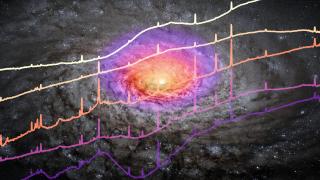Bibcode
Mejía-Restrepo, Julian E.; Trakhtenbrot, Benny; Koss, Michael J.; Oh, Kyuseok; den Brok, Jakob; Stern, Daniel; Powell, Meredith C.; Ricci, Federica; Caglar, Turgay; Ricci, Claudio; Bauer, Franz E.; Treister, Ezequiel; Harrison, Fiona A.; Urry, C. M.; Ananna, Tonima Tasnim; Asmus, Daniel; Assef, Roberto J.; Bär, Rudolf E.; Bessiere, Patricia S.; Burtscher, Leonard; Ichikawa, Kohei; Kakkad, Darshan; Kamraj, Nikita; Mushotzky, Richard; Privon, George C.; Rojas, Alejandra F.; Sani, Eleonora; Schawinski, Kevin; Veilleux, Sylvain
Referencia bibliográfica
The Astrophysical Journal Supplement Series
Fecha de publicación:
7
2022
Número de citas
60
Número de citas referidas
54
Descripción
We present measurements of broad emission lines and virial estimates of supermassive black hole masses (M BH) for a large sample of ultrahard X-ray-selected active galactic nuclei (AGNs) as part of the second data release of the BAT AGN Spectroscopic Survey (BASS/DR2). Our catalog includes M BH estimates for a total of 689 AGNs, determined from the Hα, Hβ, Mg II λ2798, and/or C IV λ1549 broad emission lines. The core sample includes a total of 512 AGNs drawn from the 70 month Swift/BAT all-sky catalog. We also provide measurements for 177 additional AGNs that are drawn from deeper Swift/BAT survey data. We study the links between M BH estimates and line-of-sight obscuration measured from X-ray spectral analysis. We find that broad Hα emission lines in obscured AGNs ( $\mathrm{log}({N}_{{\rm{H}}}/{\mathrm{cm}}^{-2})\gt 22.0$ ) are on average a factor of ${8.0}_{-2.4}^{+4.1}$ weaker relative to ultrahard X-ray emission and about ${35}_{-12}^{\,+7}$ % narrower than those in unobscured sources (i.e., $\mathrm{log}({N}_{{\rm{H}}}/{\mathrm{cm}}^{-2})\lt 21.5$ ). This indicates that the innermost part of the broad-line region is preferentially absorbed. Consequently, current single-epoch M BH prescriptions result in severely underestimated (>1 dex) masses for Type 1.9 sources (AGNs with broad Hα but no broad Hβ) and/or sources with $\mathrm{log}({N}_{{\rm{H}}}/{\mathrm{cm}}^{-2})\gtrsim 22.0$ . We provide simple multiplicative corrections for the observed luminosity and width of the broad Hα component (L[bHα] and FWHM[bHα]) in such sources to account for this effect and to (partially) remedy M BH estimates for Type 1.9 objects. As a key ingredient of BASS/DR2, our work provides the community with the data needed to further study powerful AGNs in the low-redshift universe.
Proyectos relacionados

Actividad Nuclear en Galaxias: una Perspectiva 3D del Núcleo y su Entorno
Nuestro proyecto puede dividirse en dos líneas principales de investigación. En primer lugar, el estudio de los vientos producidos por cuásares luminosos oscurecidos y del impacto que estos tienen en sus galaxias anfitrionas (retroalimentación del AGN). Para ello hemos obtenido observaciones en el óptico e infrarrojo cercano con el Gran Telescopio
Cristina
Ramos Almeida